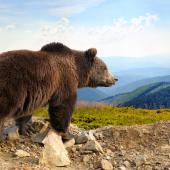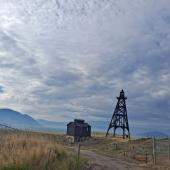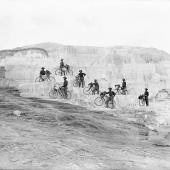Visiting Charlie Russell at Bull Head Lodge

Historians say the cowboy era of the West only lasted about 30 years, beginning with the end of the Civil War, and ending in 1895 with the decline of the open range. Charlie Russell's life circumscribed that same period. Born in 1864, he would see the cowboys rise and fall, and live to tell, or paint, or sculpt the tale for a few short decades before he, too, became a figure of legend.
And it is no small part due to Charlie Russell that the brief interlude of history which we call the Wild West is so vividly remembered in our global consciousness. He showed us what the West looked like to him, and the rest of us still can't get enough.
Some ten years after the historical demise of the cowboy era, Charlie Russell built Bull Head Lodge on the southern end of Lake McDonald. Charlie and his devoted wife Nancy would spend every summer there from 1907 until the end of his life. It would become his favorite place in the world; a refuge away from the troubles of the world, a warm hearth in the middle of a vast and untouched wilderness, and, in quiet moments, a studio where Russell would paint.
Charlie had camped and stayed in the area we now call Glacier National Park for years before he built a house there, taking inspiration from the stunning scenery and falling in love with the wildlife. After deciding to become a full-time artist in 1892 at the urging of his shrewd and ambitious wife Nancy, he began to find success as an artist and illustrator. The better his work became, the more in demand were his talents. Finally, enjoying the fruits of his success, he bought a small parcel of land previously staked in a homestead claim by Dimon Apgar, the namesake of the present-day Glacier Park village.
Charlie and Nancy named their Edenic retreat Bull Head Lodge after the bison skull with which he had signed his work since his earliest output. A bison skull placed on the shore was also the only indication, approaching from the lake, that the compound was there, nestled back in the trees.
Charlie employed local builders to construct a one-story log studio out of hand-hewn logs chinked with quartered poles. The gabled roof shaded a small porch that led to a stone path. This served as the only building on the property until 1916 when the Russells had E. J. Cruger and Martin Sibley construct another log building, this time chinked with mortar, that included a loft with a balcony and a shingled gable roof. Sunlight showed through eight casement windows, illuminating a large fireplace into which Charlie and his friend Philip Goodwin etched sixteen scenes. The rest of the interior, aside from a kitchen area with a dining table, was divided by elegant framed standing screens. Many of Charlie's guests at the house would sign the screens, and the artistically inclined would draw little figures on them.

Between the guest book (still extant) and the screens, the names of 300 or so guests appear, including many familiar to the Russell-ologist: fellow artists like Joe De Yong, Olaf Seltzer, and Maynard Dixon; friends like the writer and ethnographer Frank Linderman and Josephine Trigg, the firebrand suffragist and long-time city librarian who donated many of her C. M. Russell paintings to the city of Great Falls upon her death; and even some of the celebrities of the day, like author Mary Roberts Rinehart, dubbed the "American Agatha Christie."
At Bull Head Lodge, guests would enjoy the unpretentious cabin, sitting on its deck or going out on the lake to fish. In the evenings, people collected outside to hear Charlie Russell tell stories while someone tended to the steaks or fish frying over the large fire.
After 1914, Charlie and Nancy would sometimes entertain larger parties in the lobby of the newly re-built Lewis Glacier Hotel, amongst a wealth of bear rugs, taxidermied fauna, and faux-Native-American decor. Some rumors have Charlie designing the "Indian" motifs on the large fireplace. They would also meet the train there, to sell paintings.
Guests usually arrived via the luxuriously appointed Oriental Limited to find a smiling Charlie greeting them, ready to take them across the lake in a boat. For Charlie's sometimes rarified Eastern guests, it must have seemed like stepping into an impossible storybook landscape: as Hipólito Rafael Chacón, Professor of Art History and Criticism at the University of Montana-Missoula observed, Charlie "transformed the neighboring woods with their lush undergrowth and dappled light into a kind of fairyland that everyone seemed to enjoy." Indeed, he populated his fairyland with hand-made gnomic figures assembled from birch bark, pine cones, and found objects.
 This sense of Bull Head Lodge as a place on the borderland with fantasy was fostered further by frequent play-acting and dress-up games. Charlie and his guests would don the clothes of storybook figures, characters of romance—sometimes an Arab sheikh, a princess, a noble Indian chief, or even a stalwart cowboy, for as Charlie wrote to the silent film actor Douglas Fairbanks in the early 1920s, "the old time cow man right now is as much history as Richard the Lion Harted or any of those gents that packed a long blade and had their cloths made by a blacksmith... long haired Wild Bill Hickock with a cap and ball Colts could have made a correll full of King Arthur's men climb a tree." It was not uncommon for plays to be performed, or for Charlie and Nancy to do Indian sign language skits to the amusement of watchers. After 1916, when Charlie and Nancy adopted their only child, Jack Cooper Russell (1916-1996), at least one child could be counted on to stay summers at Bull Head Lodge.
This sense of Bull Head Lodge as a place on the borderland with fantasy was fostered further by frequent play-acting and dress-up games. Charlie and his guests would don the clothes of storybook figures, characters of romance—sometimes an Arab sheikh, a princess, a noble Indian chief, or even a stalwart cowboy, for as Charlie wrote to the silent film actor Douglas Fairbanks in the early 1920s, "the old time cow man right now is as much history as Richard the Lion Harted or any of those gents that packed a long blade and had their cloths made by a blacksmith... long haired Wild Bill Hickock with a cap and ball Colts could have made a correll full of King Arthur's men climb a tree." It was not uncommon for plays to be performed, or for Charlie and Nancy to do Indian sign language skits to the amusement of watchers. After 1916, when Charlie and Nancy adopted their only child, Jack Cooper Russell (1916-1996), at least one child could be counted on to stay summers at Bull Head Lodge.
Jessie Lincoln Mitchell wrote a story about Charlie that ends at Bull Head Lodge and just might exemplify the kind of host Charlie was. While in New York City, which in contrast to Bull Head Lodge was one of his least favorite places, Charlie found himself in one of those modern art galleries. He stood in front of one, a confused tangle he told Mitchell "fascinated him to realize any human mind could conceive such a thing."
Charlie realized someone was standing behind him. It was the artist, who recognized him and asked him what he thought. Charlie told him he couldn't say, because he didn't know what it was. The man told him it was called "The Inner Man." Charlie told him the inner man needed a doctor "durn quick." Improbably, they ended up going to lunch.
As related by Mitchell, Charlie said that "he was a hell of a good sport... I took it he wasn't too much put out the way I felt about his Inner Man. Later I found out all his mind wasn't so mixed up, for we got to be good friends, and the following summer he and his wife visited us at our summer cabin on Lake McDonald. We hit the trail together often, and I sorter feel he's not so mixed up now..."
In 1923, Charlie tripped on the slope outside of the cabin, sustaining an injury that would haunt him for the remaining three years of his life. In 1925, Charlie and Nancy cut their summer at Bull Head Lodge short to avoid a raging wildfire that nearly claimed the lodge. C
harlie would die the next year before getting another chance to visit his favorite place. Nancy, less enamored of the rustic setting in the absence of her husband, moved to southern California with Jack, never to return.
Today, like Russell himself, Bull Head Lodge belongs to us all. Located off the Going-to-the-Sun Road, it is on the National Register of Historic Places. But it is also part legend: the legend of Charlie Russell, and the legend of the West, with which he has become synonymous. The yearning for that vanished West so clearly communicated in his paintings is still with us, as ardently embedded as ever in the American story.
Would Charlie, a deeply nostalgic man himself, smile to think how he has himself become an object of intense nostalgia?
After all, what would you give to have stayed at Bull Head Lodge as the guest of the real Charlie Russell, and hear him tell stories in his inimitable voice?












Leave a Comment Here